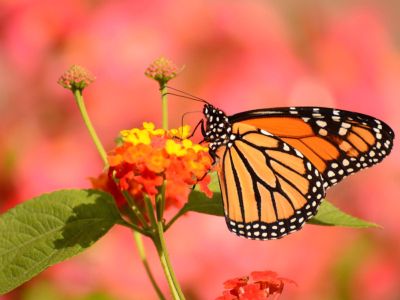Butterfly Garden Benefits
Why butterflies matter? Besides being important pollinators, butterflies impact the whole environment. Their welfare is increasingly compromised by loss of habitat due to deforestation and widespread pesticide use, as well as changes in climate and weather. By planting butterfly gardens, people can help conserve butterflies as well as other native insects and help perpetuate native plant species.
How are Butterflies Good for the Garden?
Attracting butterflies to the garden by planting a variety of native and cultivated plant species help sustain plant diversity and attract other beneficial insects to the garden such as native bees and ladybugs. Butterflies require certain plants to lay their eggs on, so someone wanting to bring more butterflies to their yard needs to research what plants butterflies in their area need and plant those specific native grasses, perennials, shrubs and trees, as well as cultivated varieties. For example, milkweed is the only plant eaten by monarch caterpillars, while the pawpaw tree serves as a food source for the zebra swallowtail caterpillar. Nectar plants such as lantana and zinnia feed the adult butterflies. But there are more reasons to help conserve butterflies. Benefits of butterflies include:
Butterflies are important pollinators. Approximately one-third of all plants need pollination to set fruit, and bees and butterflies are major pollinators. Flower nectar is the food for adult butterflies and by flying from flower to flower sipping nectar, pollination occurs.
Butterflies serve as a barometer of how the environment is doing. Through their delicate nature, butterfly numbers can decrease quickly when something is amiss in the ecosystem. By studying butterfly populations, scientists are alerted early to problems affecting all living things, including humans.
Gardening for butterflies means reducing or eliminating the use of pesticides. This in turn will bring more beneficial wildlife to the garden, such as spiders, ladybugs, praying mantids and dragonflies.
Butterflies assist with the cycle of life. Butterflies at all stages are a food source for other animals in the food chain such as birds, lizards, frogs, toads, wasps, and bats, among others.
They provide educational value. Their metamorphosis from egg to caterpillar to chrysalis to butterfly is a great teaching tool. Schoolchildren often study them as an introduction to the wonders of nature. Butterflies bring an awareness of nature to those who observe them, as well as joy and relaxation.
Conserving butterflies not only benefits the plants and animals that depend on them, but the future well-being of the environment.
